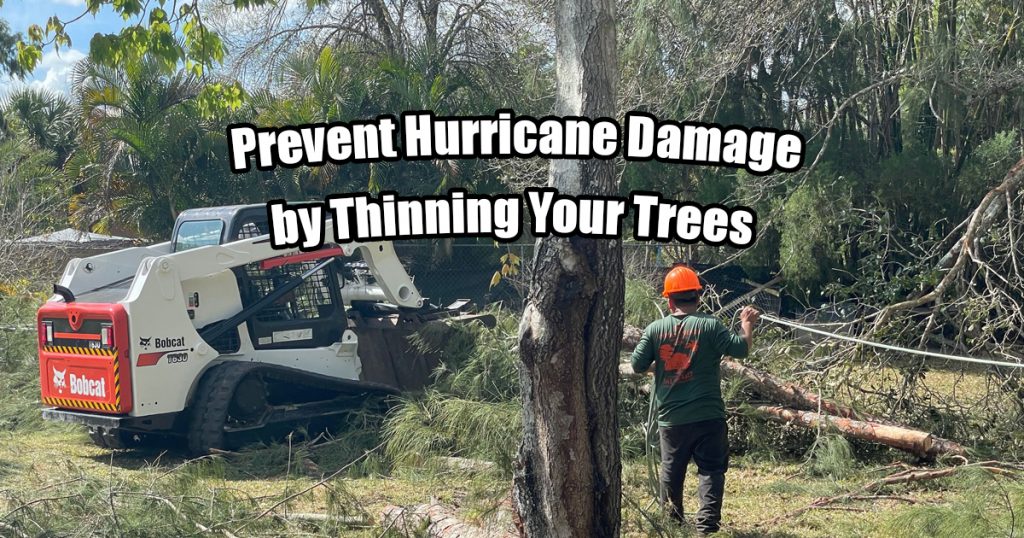
Trees are some of the strongest plants nature has to offer, but a strong storm can give them a run for their money. If you live in an area that is prone to strong winds and hurricanes, preparing your trees in advance could help limit storm damage. Hurricanes and other tropical storms are some of the leading causes of landscape damage, but with our tree thinning tips, you can help your property become as close to hurricane-resistant as possible.
Choose The Right Trees For Your Climate
The best way to help reduce storm damage to your landscape is by planting wind and hurricane resistant species. Compact trees with low gravity centers are easier to manage during hurricane season than others. Look for trees that have a single dominant trunk such as oak trees and also those that have straight roots. Trees that have spaced branches are also ideal when battling high winds. For existing trees that do not already feature a single trunk or spaced branches, professional pruning can make them uniform. If you have slender trees or tall trees on your property, you can help protect them from storms through proper pruning, or by removing them completely.
Why Pruning Is Critical To Prevent Hurricane Damage
If you live in the South East areas of the United States, then you already know how extreme weather is often a matter of concern. There are many types of risk associated with extreme weather, and strong winds tend to affect trees more than any other type of weather. There is not much that can be done to stop mother nature, but there are several ways you can protect your property and your trees from a hurricane.
Thinning your trees ahead of a hurricane or even just ahead of the usual storm season can make your trees stronger. Thinning helps to eliminate stress on the trees by reducing the competition for water, nutrients, and light among the branches. Thinning also helps to trigger growth by reducing timber rotation lengths.
Extreme wind and straight-line winds pose the most danger to trees. This type of wind can cause broken branches, gaps in the canopy, and even cause a tree to fall over. The inner portions of the tree are at a lower risk of damage mainly because the outer edges work to reduce wind speeds. If there is too much density, however, it can cause trees to sway and knock into each other during a wind event. Improper thinning can increase wind damage, however, trees properly thinned allow more wind to pass through instead of causing sway. For certain tree species, this can mean the difference between toppling over and surviving a hurricane.
Stay ahead of hurricane season and let us help you ensure that your property is ready for the next storm!
How To Prune Trees For Hurricane Season
Pruning for wind resistance is critical if you want your landscape to survive hurricane seasons. Young trees should be trained in a way that allows them to develop a well-spaced framework of sturdy branches. The healthy branches should also remain along the dominant trunk and extend as high as possible. With this strong beginning, a certified arborist can prune your trees ahead of hurricane season in a way that will better allow them to survive the strong winds.
Any tree that is taller than 12 feet should be pruned in a way that will help boos wind resistance. Dead branches that pose a hazard to your property should be removed, and any branches that are week should also be trimmed. If your trees have very long branches, shortening them is critical if you want to avoid storm damage. Branches with cracks, even if they are healthy should also be shortened or removed completely. Older branches on the tree that have the same or close diameter as the trunk should also be cut to a shorter length. The outer edges of your tree canopy should be thinned to reduce the chances of falling over in strong winds. Make sure only the outer canopy is thinned, and not the inner canopy which may cause the tree to go into shock.
We are experts in making sure that every tree is trimmed in the safest way. Give us a call to find out more.
When To Prune Your Trees
For those who live in areas that are prone to extreme weather, it is often easy to plan the best time to prune your trees. The best time for pruning is always in the winter, however, it is also a good idea to trim your trees a month or two before hurricane season. Trees can work to protect your home and property from strong winds, but if they are top-heavy or have broken branches, they may do more harm than good. Never prune your trees when a hurricane alert or hurricane watch has been posted. Not only will this put you in danger if you are caught in the storm, but urgent pruning also won’t give your tree enough time to heal from the shock.
The majority of fallen trees found after the storm are those that were already weakened and those that were improperly pruned. Speak with a certified arborist licensed to care for trees to create a customized plan for your landscape. Avoid “Hatracking” your trees as this will cause them to go into shock or even fail. There should never be more than 25% of the canopy removed during any pruning session unless existing damage or disease is harming the tree. The roots are a critical part of the tree, under no circumstances should they be cut.
Additional Benefits Of Tree Pruning
Strategically pruning ahead of a hurricane will help keep your tree from getting damaged and make them more stable. In addition to protecting them from high winds, pruning also offers an additional range of benefits. Pruning can help you spot health issues in the tree that may have been hidden under the surface. If you notice tree stress, then you can cable and brace the tree in advance to give it extra support during the storm season. Another benefit is getting rid of tree hazards. The last thing you want is to see a broken tree limb flying towards you in the middle of a hurricane.
